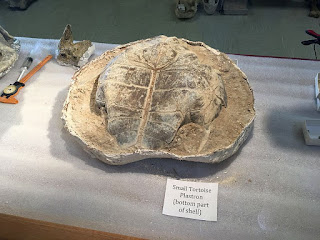 |
| Hubbell Rhino Barn |
After paying the admission fee and NE State Park Parking fee you walked into a very nice visitors center. There was naturally a gift shop, a worker, who I guess was a grad student, behind glass and working on fossils, and then some specimens.
I guess to straighten things out right away that the fossils in this bone bed aren't dinosaurs, the first station informed the visitor that during the Cretaceous time, Nebraska and most of the Plains were under an inland sea -
 |
| Pleisosaur neck vertebrae |
The visitor's center showed a nice mural of the area before the catastrophe -
Then it goes on to show some of the fossils from the bone bed. There are 3 categories of fossil on the site. One that was before the ash fall. Fossils that happened because of the ash fall. Then fossils found in the layers after the ash fall, which indicates that after the catastrophe was over, the animals eventually returned to the area.
Species of elephants were discovered before and after the ash fall -
Carnivores were also found in the sediments under the ash -
Dating the ash fall, it was determined that it occurred about 11+ million years ago from a volcano that erupted in south western Idaho dropping about a foot of ash over the area. The smaller animals, including turtles, birds and small mammals dies first -
Then larger animals such as camels died a few days to a week after. Up to 5 species of horses including both single hoof and 3 toes horses were next -
Finally a week weeks after the ash fall, the larger animals like the barrel body rhinos (Teleoceras) succumbed to suffocation. It has been thought that they stuck around the water as comfort, when it actually sped their demise.
After the animals were dead it was determined that the wind blew the ash to a depth of 10-12 feet that quickly covered the bodies. Also as the animals decomposed the ash filled the voids, so not only are the animals almost 100% articulated, they are also 3-D giving an accurate look how they really were.
Evidence of predation was also found; not the carnivore, but bite marks and some fossils that were disarticulated -
Finally it was time to head to the Rhino Barn. On the way was a sculpture of two of the rhinos Teleoceras -
 |
| Sign on the barn. |
 |
| A pano view upon entering the 17,000 sq. ft. Barn |
There were two paleontologists (grad students?) working in the ash pit. The worker imaged was uncovering a horse skull as we watched. They were ready to answer questions and were very friendly -
Opposite the pit was a wall of posters illustrating the animals that were found on site. I liked them so much I imaged nearly all of them. I also gave them their own post HERE.
The rest of the sights were -
 |
| Deer leg bones |
 |
| Rhino tracks in the waterhole sand |
 |
| A small 3 toed horse |
One of the things learned was that the rhino herded in a harem style. Only one male was found here with many females. Also a number of babies were found that looked to be about the same age. This indicates that there was most probably a birthing season.
 |
| An adult female Rhino |
 |
| Another perfectly preserved 3 toed horse |
 |
| A female rhino pelvis with an unborn calf within |
Below is a pano of the far side of the barn. A early smaller barn was built and in a few years all the animals within were exposed. The second current barn, which is much larger was built after the site receiving needed grant money.
 |
| A mare, foal and baby rhino are located here |
The indication of the waterhole soil and the ash -
Going outside of the barn, bones were found dated after the ash fall.These are left to weather naturally out of the ground -
Also a collection of micro fossils were found In a separate "education" building, there was an excellent topographic map of Nebraska with the AshFall site indicated. I just love topo maps so here -







































No comments:
Post a Comment